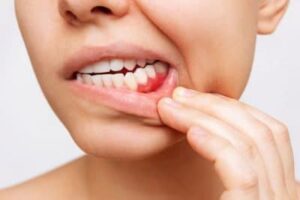
However, they’re not the same half. Men experience gum disease, too. Even here in Chula Vista (it’s one of the diseases that our Southern California lifestyle doesn’t protect us from). Since gum disease is the leading cause of tooth loss among adults and can contribute to numerous serious health risks, it’s important to understand it.
What Is Gum Disease?
Gum disease is when oral bacteria infect the space around your tooth. That’s why it’s also known as periodontal disease: “perio” means “around” and “dontal” means “tooth.” However, as we’ll see, periodontal disease isn’t just related to bacterial infection.
There are three types of gum disease.
Gingivitis
Gingivitis is a relatively mild form of gum disease. In gingivitis, you might notice red, swollen, painful gums. Your Chula Vista dentist might measure an enlargement of the spaces around your teeth. That’s because oral bacteria are attacking your gums to make more room for themselves. This reduces the amount of attachment between your teeth and jaw. However, your teeth likely aren’t loose yet.
Gums bleed in response to brushing and certain foods, but they don’t bleed spontaneously in gingivitis. You also have only minor gum recession, if any.
Periodontitis
Periodontitis is a severe form of gum disease. In periodontitis, you experience symptoms not only of bacterial infection but of the body’s elevated immune response. Chronic inflammation can put you at risk for autoimmune disorders. The body begins to attack the gums and jawbone in a “scorched earth” campaign to kill the increasingly severe bacterial infection.
Gums bleed spontaneously. You’ll have noticeable gum recession. Teeth drift out of place and may be noticeably loose. You might also experience sensitivity to heat, cold, and pressure. Eventually, you will lose teeth.
Peri-implantitis
Peri-implantitis is when gum disease develops around dental implants. Dental implants don’t get cavities, but they are still vulnerable to gum disease. In fact, gum disease is the leading cause of dental implant failure after the first year.
Scientists aren’t sure if peri-implantitis is the same disease as periodontal disease. The symptoms are very similar: inflamed gums that eventually recede, plus loss of bone around the implant leading to implant loss. However, some scientists claim the bacteria involved are different enough that we should consider them different conditions.
How Gum Disease Risk Can Change over a Woman’s Lifetime
A number of factors influence a woman’s periodontal health. In addition to diet and oral hygiene habits, a woman’s hormone levels can contribute to her gum disease risk. The two hormones that contribute to periodontal gum disease in women are the sex hormones estrogen and progesterone. Both of these increase blood flow to the gum tissue, causing its increased sensitivity to bacteria and other offending agents.
In addition, some studies say increased levels of estrogen and progesterone actually promote the growth of disease-causing bacteria. As a result, the gums become easily swollen.
The following conditions are some of the instances where women’s hormones fluctuate, causing them to be more susceptible to periodontal disease.
Puberty:
During puberty, there is an increased level of progesterone which causes the gums to appear red and swollen. Gums are also likely to bleed easily upon slight manipulation. This reaction of the gum tissue can easily be reversed by removing the irritant. This can be done through meticulous oral hygiene practices and regular professional cleaning by your Chula Vista dentist.
Nonetheless, as the pubertal period ends, this reaction tends to lessen. Even so, it is still important to take good care of your oral health.
Menstruation:
Some women may also experience menstruation gingivitis. This gingivitis appears about three to four days before a woman’s period and begins to clear up after her period ends.
In some cases, the salivary glands may also become swollen. While the tongue and the inside of the cheek may develop painful sores. Some women, though, don’t experience any changes at all. For those who experience any discomfort, your Chula Vista dentist may recommend cleaning, topical anesthetics, or other special treatments to provide some relief.
Pregnancy:
Numerous studies have long suggested pregnancy as a possible risk factor for periodontal gum disease, as it causes hormone levels to rise considerably. Gingivitis is present during the second month of pregnancy up to the eighth month, and it starts to wane during the ninth month.
To control the disease, your Chula Vista dentist may prescribe more frequent cleaning visits to control the disease, especially during the second trimester or early third trimester. Sometimes, an overgrowth of tissue called a “pregnancy tumor” may appear during the second trimester.
The association between these two conditions is a two-way street as hormonal fluctuations during pregnancy may predispose to periodontal disease, while an infectious disease like periodontal disease poses a risk to the unborn baby’s health.
According to studies, periodontal disease causes pregnant women to have premature and/or low birth weight babies. Expectant mothers need to take special care of their oral health.
Menopause:
A small percentage may also develop menopausal gingivostomatitis, which is described as dry, shiny gums that bleed easily. The color of the gums ranges from very pale to deep red. According to some experts, supplementation with estrogen may help relieve symptoms.
Maintain Oral Health in Chula Vista
Every phase of a woman’s life brings about many good changes, while others may present challenges for maintaining oral health.
Talk to your Chula Vista dentist or periodontist if you start to see or feel any changes that you think may be related to any of the conditions above. They will be more than happy to address any concerns regarding your oral health.
For help achieving and maintaining oral health in Chula Vista, please call (619) 656-6785 or online to schedule an appointment at our office in the Rancho del Rey neighborhood.
